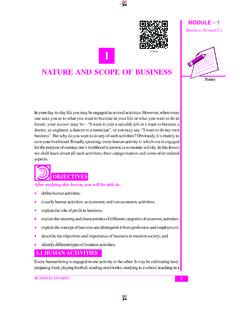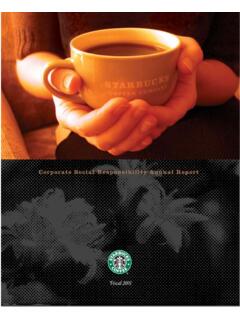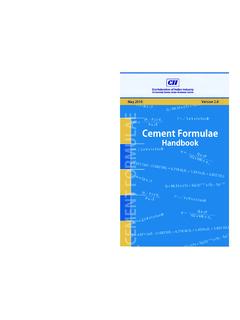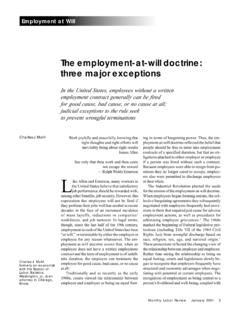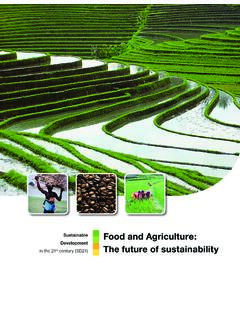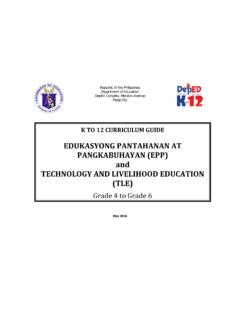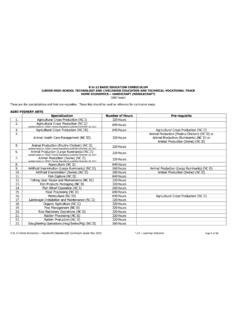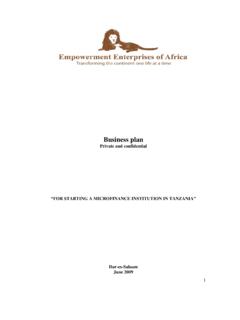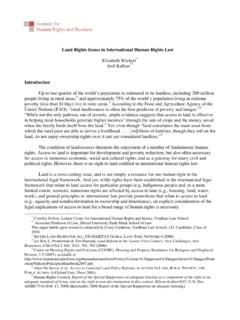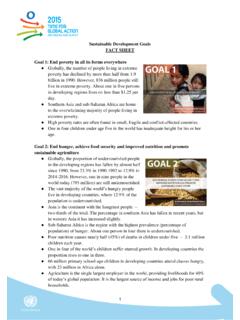Transcription of The Socio-Economic Impact of the COVID-19 Pandemic in ...
1 1 The Socio-Economic Impact of the COVID-19 Pandemic in Saint Lucia: Findings from the Saint Lucia COVID-19 High Frequency Phone Survey ( COVID-19 HFPS)1 Analysis of the 1st round of data collection (May 5 to 18, 2020) August 5, 2020 1 This report was prepared jointly by the Saint Lucia Central Statistics Office and the World Bank. The World Bank team included Freeha Fatima, Kexin Zhang, Xiaomeng Chen, Xueqi Li, Dixita Gupta, Akosua Asare, Miyoko Asai, Anna Luisa Paffhausen, Silvia Malgioglio, and Nobuo Yoshida. From the Saint Lucia Central Statistics Office, Sean C. Mathurin, Emmanuel Dalsou, Urmain Gray, and Edwin Saint Catherine (Consultant) contributed to this report. We would also like to thank Aldo Morri for his careful reviews.
2 2 Contents 1. Introduction .. 4 2. Sampling and data collection .. 7 3. Results .. 8 Knowledge on preventive measures and policies against COVID-19 .. 8 Socio-Economic effects of the COVID-19 Pandemic and related policies .. 9 Public Government and NGO Transfers .. 19 4. Conclusions .. 21 References .. 21 ANNEX .. 22 A1: Poverty projection prior to the COVID-19 outbreak (preliminary) .. 22 A2: SWIFT Methodology .. 22 A3: Reweighting Strategy .. 24 A4: Additional Figures .. 26 3 Figure Contents Figure 1. Information received on preventive measures .. 8 Figure 2. Adoption of preventive measures .. 8 Figure 3. Lack of Access to Food and Basic Services .. 10 Figure 4. School Closing and Children s Engagement in Learning Activities.
3 11 Figure 5. Employment Status .. 12 Figure 6. Employment Status in the week prior to the survey .. 13 Figure 7. Reasons for not being able to go to the workplace in the week prior to the survey .. 13 Figure 8. Employer Benefits .. 13 Figure 9. Advance notice (number of days) .. 13 Figure 10. Income Changes from Family Business .. 15 Figure 11. Reasons for loss in income from family business during COVID-19 .. 15 Figure 12. Main Reasons for not being able to Perform Normal Farm Activities .. 16 Figure 13. Main Source of Livelihood .. 16 Figure 14. Income Changes from the main source of livelihood (%) .. 17 Figure 15. Food Insecurity .. 18 Figure 16. Transfers/non-labor income support from the government .. 19 Figure 17. Government Social Programs Coverage and Income Decrease.
4 20 Figure 18. Safety Nets Comparison between the Poor and Non-Poor .. 20 Table Contents Table 1. Steps taken by the government or local authorities to curb the spread of COVID-19 .. 9 Table 2. Reasons for not being able to access basic needs .. 10 Table 3. Reasons for children not being able to continue education due to COVID-19 .. 11 Table 4. Reasons for not working since March 20 .. 12 Table 5. Share of Sector of Employment before and after March 20th .. 14 Table 6. Percentage of Households with a Decrease in Income .. 17 Table 7. Government Social Programs Coverage .. 19 Table 8. Government Social Programs Coverage and Food Insecurity .. 20 4 1. Introduction This report summarizes key findings from the first round of the High Frequency Phone Survey ( COVID-19 HFPS) in Saint Lucia, which the World Bank conducted in collaboration with Saint Lucia s Central Statistical Office (CSO).
5 The survey aims to monitor the Socio-Economic effects of the COVID-19 Pandemic in Saint Lucia, the first country to conduct such a survey in the Latin America and the Caribbean (LAC) region. Adapted to meet the country context, the World Bank and the CSO jointly developed the questionnaire based on the World Bank COVID-19 Global CORE Questionnaire. Data collection for the second round of this survey is taking place in late July to early August, 2020 to track ongoing Socio-Economic effects of the Pandemic and related policy responses. This information will help the Government of Saint Lucia and its development partners to design, re-design, target, and evaluate on-going and future policy interventions. Saint Lucia, an island economy of million people with a GDP of about US$ 2 billion, has recently experienced positive GDP growth ( in 2018-19) and declining However, the COVID-19 Pandemic is causing a severe reversal in economic growth in 2020 ( GDP growth projected).
6 Government statistics reported only 23 confirmed COVID-19 cases, with no deaths and 19 recoveries as of July 20, 2020, partially due to proactive and early government response. The National Television Network has broadcasted a series named COVID-19 : The Road to Recovery with a focus on rebuilding the economy in the new COVID-19 context. In addition, the Government has initiated Phase 1 of its Responsible Reopening Plan3 to allow tourism activity so people can slowly regain access to income-generating According to the COVID-19 High Frequency Phone Survey (HFPS), households across all geographic and Socio-Economic groups are well-aware of the COVID-19 Pandemic and key preventive measures. Around 90 percent of respondents knew 9 out of 10 preventive measures suggested by the Center for Disease Control and Prevention (CDC) and the World Health Organization (WHO) and adopted some of these key measures.
7 A key feature of the COVID-19 HFPS is the ability to measure household welfare using the World Bank Group (WBG) Survey of Wellbeing via Instant and Frequent Tracking (SWIFT) tool. The SWIFT approach allows imputation of household-level consumption expenditures from responses to some key questions known to be important correlates of poverty. This allows identification of households likely to be poor and non-poor, which not only enables us to assess how the impacts of the Pandemic vary with differing poverty status, but also guides us in understanding differences in behavioral responses. In this first round of the COVID-19 HFPS, we used SWIFT to identify households likely to have been poor and non-poor prior to the COVID-19 outbreak and estimate profiles of these households (details on the application of the SWIFT methodology in this survey can be found in Annex A2).
8 Interpretation of results from this survey should keep in mind the caveats of phone-based data collection. These include selection bias towards the population owning a mobile phone (heterogeneity in coverage and usage) and non-response due to respondent refusal or inability to reach a working number. Given these potential limitations, we use a propensity score matching (PSM) reweighting strategy (see Annex 2 World Bank Macro Poverty Outlook for Saint Lucia (2019). 3 Tourism is the leading economic sector in Saint Lucia, contributing an estimated 10 percent of GDP and direct employment for approximately 20,000 people. 4 Saint Lucia s economy is highly dependent on tourism, which accounts for half of GDP and employment.)
9 5 A3 for details on the methodology) to extrapolate the nationally representative statistics presented and discussed throughout this report. Results are organized in 3 main themes: (a) Knowledge on preventive measures and polices against COVID-19 ; (b) Socio-Economic effects of the COVID-19 Pandemic and related policies; (c) Public Government and NGO transfers. (a) Knowledge on preventive measures and policies against COVID-19 . Early government information campaigns proved useful in imparting knowledge of preventive measures to the majority of the population. More than 90 percent of Saint Lucians are aware of major preventive measures, except for using gloves, and the survey shows key measures are largely practiced.
10 (b) Socio-Economic effects of COVID-19 Pandemic and related policies. COVID-19 had a huge effect on living conditions and livelihoods in Saint Lucia in terms of access to basic needs and services, employment, income, and food security. Some key findings include: Access to basic needs has been severely restricted. About 15 percent of households experienced difficulty in accessing basic needs such as food and medicine since the COVID-19 outbreak. Poor households are around 10 percent more likely to face these constraints than non-poor. Large income and job losses occurred. More than 70 percent of respondents report their household income having declined since the COVID-19 outbreak. Also, more than 40 percent of respondents working prior to COVID-19 were not working during the survey.
